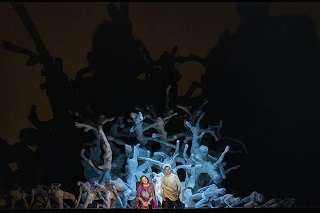|
Back
Love Sublimated Bologna
Teatro Comunale
01/24/2020 - & January 26, 28, 29, 31, 2020
Richard Wagner: Tristan und Isolde
Stefan Vinke*/Bryan Register (Tristan), Ann Petersen*/Catherine Foster (Isolde), Ekaterina Gubanova (Brangäne), Martin Gantner (Kurwenal), Albert Dohmen (König Marke), Tommaso Caramia (Melot, A pilot), Klodjan Kaçani (A shepherd, A young sailor)
Coro del Teatro Comunale, Alberto Malazzi (chorus master), Orchestra del Teatro Comunale, Juraj Valcuha (conductor)
Ralf Pleger & Alexander Polzin (artistic concept), Ralf Pleger (stage director), Alexander Polzin (sets), Wojciech Dziedzic (costumes), John Torres (lights), Fernando Melo (choreography)

(© Rocco Casaluci)
Historically, Bologna has been Italy’s most Wagnerian city. It saw the first performance of a Wagner opera in Italy and the Italian premieres of most of his operas. The 2020 Teatro Comunale’s season opened with an extraordinary production of Tristan und Isolde. It was exceptional for the overall vocal excellence of the singers, the sensitive conducting of Juraj Valcuha and most of all for Ralf Pleger’s brilliant staging. The most supreme love story, Tristan und Isolde shattered opera and music for more than the famous Tristan chord. It is a long opera (5 hours with 2 intermissions) with a very simple story.
A conventional staging of the story can be tedious. Ralf Pleger’s vision goes to the essence of this immense love: it is not the mere narration of the story, but the metaphysical examination of an overwhelming passion. Brilliantly, Pleger does not show the two lovers drinking the love potion that Brangäne deliberately provides instead of the poison demanded by Isolde. One has doubts whether such a potion was ever drunk or even necessary for what has been the most ardent passion since Isolde set her eyes on Tristan, as recounted in her first Act I narration.
Isolde’s fury against Tristan for taking her as a bride for his uncle, King Marke, is shown by a cage superimposed on her costume. By the end of the Act, when the two lovers uncontrollingly drown in their passion, the cage is gone. The fury has yielded to unadulterated and unstoppable passion. The sails of the ship in the first act are stalactites that move toward the ground every time there’s a burst of passion. By the end of the first act, almost all the stalactites have reached the ground as the lovers are in the euphoria of their passion. The back wall of the ship is a mirror, reflecting the characters on stage, possibly insinuating to two states of existence: the real and the subconscious. The mirror also reflected the Teatro Comunale’s interior, which was an allusion to the public’s involvement in Pleger’s staging: our imagination is an integral part in his narration of the story.
Vocally, the two leading roles are murderous. Both Tristan and Isolde sing for a large portion of the opera. Tristan gets some rest during Isolde’s long Act I narration (known as Isolde’s Act). Isolde gets some respite at the beginning and middle of Act III (known as Tristan’s Act). Both get a break during King Marke’s Act II long narration. German tenor Stefan Vinke was born to sing Tristan. His hefty voice is expressive, his timbre virile without being baritonal and his diction flawless. In places, his voice got hoarse but such a flaw was a minor nuisance. Danish soprano Ann Petersen was a moving Isolde. Despite a distinct metallic quality to her voice, she was able to expressively nuance her fury, passion and despair. The Liebestod was supreme despite the surprising premature applause by one spectator.
The supporting singers were mostly excellent. Most brilliant was Ekaterina Gubanova’s Brangäne, whose warm mezzo felicitously contrasted with Isolde’s soprano and convincingly conveyed this companion’s love for her mistress, especially in Act I. Motherly care was well communicated in her intervention during the Act II love duet. Martin Gantner’s Kurwenal was extremely moving. Beyond excellent diction and expressiveness in his singing, Gantner conveyed the desired qualities for the faithful servant Kurwenal: virile, humble, gruff with Isolde and Brangäne in Act I and compassionate towards his master. Less appealing was Albert Dohmen’s King Marke, whose voice is too dry. This rendered his Act II narration more tedious than usual. Klodjan Kaçani was an excellent shepherd in Act III and young sailor in Act I. His voice had both the required plaintive quality and youth. Unfortunately, Tommaso Caramia was an inadequate Melot with an ugly timbre of voice and an approximate diction.
The most memorable moment in this production was the Act II love duet. Sculptor Alexander Polzin’s ingenious structure representing the forest’s protectiveness was brilliantly conceived. It was of an organic shape of intertwined trees as well as human bodies. The latter watched Tristan and Isolde throughout the duet and reacted to the different states of passion. They also provided an eeriness, most appropriate for the Celtic legend. This structure was a metaphor for the lover’s passion – beyond time and space. A rigourist observer could easily contest such liberties in staging, but the mesmerizing effect of Wagner’s music somehow enhanced the visual spell. Ingenious use of lighting to accentuate the different stages of passion was admirable throughout the opera. It was most effective in Act III where Tristan suffers from too much light, a metaphor for reality. One could feel the sun’s heat thanks to the blinding light. This exceptional co-production with Brussel’s La Monnaie Opera reaffirms Bologna’s status as Italy’s leading Wagnerian city. Indeed, more Wagner productions are programmed in the coming seasons. A pilgrimage to Bologna may be a worthwhile project during the next few seasons.
Ossama el Naggar
|